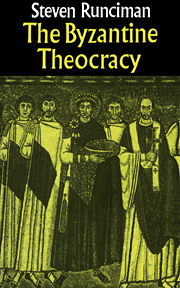Book contents
- Frontmatter
- Contents
- Foreword
- Introduction
- 1 The Christian Empire: The image of God upon earth
- 2 The Viceroy of God: The plenitude of Imperial power
- 3 The battle over images: The challenge of popular belief
- 4 The working compromise: The limits of Imperial control
- 5 The monks and the people: The opposition to the palace and the hierarchy
- 6 Decline and fall: The end of the Kingdom of God on earth
- Notes
- Index
3 - The battle over images: The challenge of popular belief
- Frontmatter
- Contents
- Foreword
- Introduction
- 1 The Christian Empire: The image of God upon earth
- 2 The Viceroy of God: The plenitude of Imperial power
- 3 The battle over images: The challenge of popular belief
- 4 The working compromise: The limits of Imperial control
- 5 The monks and the people: The opposition to the palace and the hierarchy
- 6 Decline and fall: The end of the Kingdom of God on earth
- Notes
- Index
Summary
Justinian's successors inherited his problems and his methods. His nephew, Justin II, though Orthodox himself, still hoped to win back the Monophysites. Early in his reign he summoned a Council to meet at Callinicum, on the Syrian border; but its first session ended in a riot. In 571 he issued a Programma, sometimes called the Second Henoticurn, an elaborately worded document which was basically Orthodox but made no mention of Chalcedon. A few moderate Monophysites subscribed to it; but it failed to satisfy general Monophysite opinion. The Emperor was exasperated, and next year, encouraged by a fanatical Patriarch, John of Sirimis, he annulled the orders of Monophysite priests and closed monasteries that were suspected of Monophysite sympathies, while prominent men and women who were attached to the heresy were imprisoned unless they recanted. This merely encouraged separatist tendencies amongst the heretics.
Justin went mad in 574. The Empress Sophia then selected a promising young soldier, Tiberius, to be Caesar and regent. He succeeded to the Empire on Justin's death in 578. He was an efficient military reformer whose attention was devoted to a war against the Persians and to seeking popularity by reducing taxation at a moment when the Treasury was almost empty. Apart from a desultory persecution of the Monophysites, he showed very little interest in religion.
His son-in-law Maurice, who succeeded him in 582, was an able general whose eyes were fixed on the East, and was therefore eager to recapture the goodwill of the Monophysites. He showed them tolerance; and, to simplify future religious policy, he planned to give to the Patriarch of Constantinople an authority over the Eastern Patriarchs similar to that which the Bishop of Rome enjoyed over the whole Western Church.
- Type
- Chapter
- Information
- The Byzantine TheocracyThe Weil Lectures, Cincinatti, pp. 51 - 76Publisher: Cambridge University PressPrint publication year: 1977



